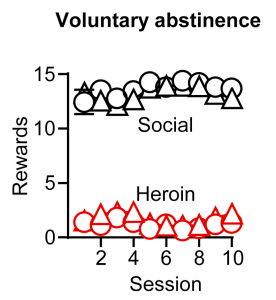 Hot Off the Press – December 18 , 2019.
Hot Off the Press – December 18 , 2019.
We recently developed a rat model of relapse after voluntary abstinence from methamphetamine self-administration that is based on behavioral treatments in humans with substance use problems. In the present study, we extend this work to heroin self-administration, demonstrating that when rats are given the opportunity to lever press for access to a social partner, they will abstain from lever pressing for heroin infusions. We also show that social choice–induced voluntary abstinence decreases the time-dependent increases in heroin seeking after cessation of drug self-administration (incubation of heroin craving). Lastly, we introduce a novel fully automated social self-administration and choice procedure.
Publication Information
Operant Social Reward Decreases Incubation of Heroin Craving in Male and Female Rats. Journal Article
In: Biol Psychiatry, vol. 86, no. 11, pp. 848–856, 2019, ISSN: 1873-2402 (Electronic); 0006-3223 (Linking).
